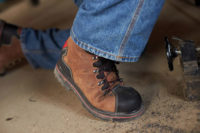
While the components of a good pair of safety boots or shoes are usually determined by their end use, a key element of most safety footwear is the safety-toe, a hard internal cap built directly into the boot or shoe. Meant to protect the toe area from sudden impact or prolonged compression, the vast majority of such caps are designed to meet or exceed the safety standards set by ASTM (American Society for Testing and Materials).
ASTM standards are determined by voluntary committees of experts and are, interestingly enough, not mandated by any formal government body. Nevertheless, virtually all reputable safety footwear manufacturers abide by the ASTM tests and standards for many reasons, not the least of which is that their customers have come to expect it from them.
Steel: the industry standard
A steel cap has been and remains the mainstay of all kinds of safety footwear featuring built-in safety-toes. When it comes to protecting the toe area from a sudden blow (a heavy box falling on the toes) or a condition of protracted compression (the toes pinned under a heavy pallet), there are few affordable materials that can meet, let alone exceed, the strength, resilience and elasticity of steel. It remains the safety-toe of choice for most.
The technology of safety-toes has, from this perspective, changed very little over time. Yet, from other perspectives and despite the continued preeminence of the traditional steel cap, changes have happened and are happening in the safety-toe industry. Here are three of the most obvious.
1. Changes in construction
The viability and reliability of a safety cap depends on both the integrity of the cap itself as well as on the soundness of the footwear platform upon which it rests. For this reason, Goodyear® welt constructions have played a dominant role in the history of safety footwear manufacturing. Aside from excellent durability, a Goodyear welted construction was and is particularly well-suited for nesting the safety cap upon a stable insole and outsole platform. Goodyear welted shoes have been and are reliably sound platforms for safety caps.
However, with advances in insole and outsole materials, coupled with progress and refinements in manufacturing processes, the predominance of welt constructions is being challenged by other kinds of footwear constructions. These range from cement lasted, as in most kinds of athletic footwear, to direct injection found in many high-grade comfort casuals.
2. New and varied shapes
Expansion of the ways in which safety footwear is manufactured has helped usher in the second area of change in safety-toe footwear: the shape of safety caps. The toe profiles of today’s safety caps are far more varied than they were even five to ten years ago. Along with the traditional mainstream types of toes, including such styles as snoot toe cowboy boots and slimmer, more tapered athletic looks, there are also several ergonomically correct and roomy oblong shapes.
3. New options in materials
Finally, even the preeminence of the steel cap has begun to come under attack from such upstart candidates as those forged from aluminum alloys or composite plastics that are either injected or thermo-formed along with fiberglass.
These newer options all seek to respond to one major drawback of steel caps: steel caps, though durable and dependable, are heavy. Aluminum and composite caps can often be 40 to 50 percent lighter than comparable steel caps.
There are, however, two notable drawbacks with these lighter weight options. First, in order to achieve the performance standards of steel, these kinds of caps have to be made bigger and thicker. This makes the shoes look bigger in the toe, but more importantly, these caps can make fitting the shoe more of a design and development challenge for the simple reason that non-steel caps take up more room inside the shoe and must, therefore, be accommodated for accordingly. Secondly, non-steel options tend to be more expensive than steel at an increased cost of about four to five dollars per pair at retail.
Still, the thickness and cost of non-steel caps has improved over the past ten years, and we can reasonably expect that in time, because of their lightweight nature, the industry shall see them become more and more comparable to the steel cap.
The changing face of PPE
Safety-toe footwear can appear to be a fairly staid and uninteresting branch of the footwear industry. But like many areas of personal protective equipment, safety-toe footwear is evolving in response to changes in the marketplace. For those required to wear it, new options are worth investigating.


